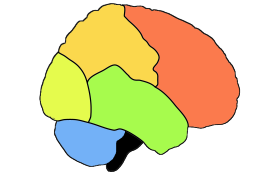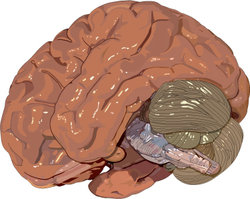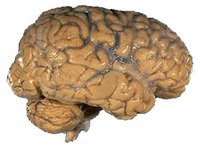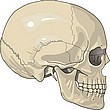Human brain
|
|
In the anatomy of humans, the human brain is the center of the central nervous system and the primary control center for the peripheral nervous system.
| Contents |
Overview
Human encephalization is especially pronounced in the neocortex, the most complex portion of the cerebral cortex. The human brain has more neocortex than other animals.
Humans enjoy unique neural capacities, but much of the human neuroarchitecture is shared with ancient species. Basic systems that alert the nervous system to stimulus, that sense events in the environment and that monitor the condition of the body are similar in some ways to those of the most basic vertebrates. Human consciousness involves both the extended capacity of the modern neocortex in particular as well as profoundly developed protypical structures of the brain stem. But the human brain is unique, in part, because it has a million billion synaptic connections, making it one of the most densely connected network systems among natural and fabricated systems found on earth.
Anatomy
The adult human brain usually weighs between 1 and 1.5 kg (three pounds) in an average volume of 1,600 cm³ (98 in³). The male brain has approximately 4% more brain cells and 100 more grams of brain tissue than the female brain. It consumes about 20% of the energy used by the body. (In infants, it consumes about 60%.) This generates a lot of heat, which must be removed to prevent damage.
A bulbous cerebral cortex is formed of convoluted gray matter internally supported by deep brain white matter and separated by a prominent central fissure. A well-developed cerebellum is visible at the back of the brain. Brain stem structures are almost completely enveloped by the cerebellum and telencephalon, with only the medulla oblongata visible as it merges with the spinal cord.
The blood supply to the brain involves several arteries that enter the brain and communicate in a circle called the circle of Willis. Blood is then drained from the brain through a network of sinuses that drain into the right and left internal jugular veins.
The brain is suspended in cerebrospinal fluid (CSF) which also fills spaces called ventricles inside it. The dense fluid protects the brain and spinal cord from shock; a brain that weighs 1,500 g in air weighs only 50 g when suspended in CSF. (Livingston, 1965). Fluid movement within the brain is limited by the blood-brain barrier, brain-cerebrospinal fluid barrier and the blood-cerebrospinal fluid barrier.
The brain is easily damaged by compression, so the fluid surrounding the central nervous system must be maintained at a constant volume. Humans are estimated to produce about 500 ml or more of cerebrospinal fluid each day, with only about 15 percent of the body's estimated 150 ml of CSF at any given time located in the ventricles of the brain. The remainder fills the subarachnoid space which separates the soft tissues of the brain and spinal cord from the hard surrounding bones (skull and vertebrae). Elevated levels of CSF are associated with traumatic brain injuries and a pediatric disease known as hydrocephalus. Increased fluid pressure can result in permanent brain injury and death.
The exceptional size of the human brain resulted in some anatomical compromises. At birth, an infant's skull is as large as it can be without causing undue peril to the mother and child. However, prior to the intervention of modern medicine, childbirth was a dangerous event that frequently resulted in the death of the mother. The difficulty experienced by humans in giving birth is nearly unique in the animal kingdom. Female humans have large pelvic openings to accommodate the birth of large-headed children, but the larger this opening, the more the ability of the mother to run is compromised.
At birth, the human skull is rather soft, and it deforms somewhat during its passage through the birth canal, then recovers its shape. This allows it to expand to make room for the brain, which continues to grow, at the same rate as that of an unborn fetus, for an additional year. In all other animals, the growth rate of the brain slows significantly at birth.
Function
The human brain is the seat of the human mind - the set of cognitive processes related to perception, interpretation, imagination and memory, of which a person might or might not be aware. Beyond cognitive functions, the brain regulates autonomic processes related to essential body functions such as respiration and heartbeat.
Extended neocortical capacity allows humans some control over emotional behavior, but neural pathways between emotive centers of the brain stem and cerebral motor control areas are shorter than those connecting complex cognitive areas in the neocortex with incoming sensory information from the brain stem. Powerful emotional pathways can modulate spontaneous emotive expression regardless of attempts at cerebral self-control. Emotive stability in humans is associated with planning, experience and an environment that is both stable and stimulating, especially during early developmental years.

The 19th century discovery of a primary motor control area mapped to correspond with regions of the body led to popular belief that the brain was organized around a homunculus. A distorted figure drawn to represent the body's motor map in the pre-frontal cortex was popularly recognized as the brain's homunculus, but function of the human brain is far more complex.
The human brain appears to have no localized center of conscious control. Like the brains of other vertebrates, it derives consciousness from interaction among numerous systems within the brain. Executive decision-making functions rely on cerebral activities, especially those of the frontal lobes, but redundant and complementary processes within the brain result in a diffuse assignment of executive control that can be difficult to attribute to any single locale.
Mid-brain functions include routing, selecting, mapping and cataloguing information, including information perceived from the environment and information that is remembered and processed throughout the cerebral cortex. Endocrine functions housed in the mid-brain play a leading role in modulating arousal of the cortex and of autonomic systems.
Nerves from the brain stem complex where autonomic functions are modulated join nerves routing messages to and from the cerebrum in a bundle that passes through the spinal column to related parts of a body. Twelve cranial nerves, including some that innervate parts of the head, follow pathways from the medulla oblongata outside the spinal cord.
A definite description of the biological basis for consciousness so far eludes the best efforts of the current generation of researchers. But reasonable assumptions based on observable behaviors and on related internal responses have provided the basis for general classification of elements of consciousness and of likely neural regions associated with those elements. Researchers know people lose consciousness and regain it, they have identified partial losses of consciousness associated with particular neuropathologies and they know that certain conscious activities are impossible without particular neural structures.
A common myth is that human beings only use ten percent of our brains. This is false; we use our entire brains. The myth likely had its source in an advertisement or a misunderstanding of neurological research in the late 1800s or early 1900s. Some psychics help to prolong this myth by asserting that the "unused" ninety percent of the human brain is capable of exhibiting psychic powers, and can be trained to perform psychokinesis and extra-sensory perception. A less literal interpretation of the statement is, however, valid. It can be reasonably claimed that most people only use a very small fraction of the cognitive potential of their brain, even though all individual brain neurons are busily working. Various cultural inventions enable humans to better utilise their cognitive potential, such as reading, education, solving puzzles, critical thinking, etc.
Study of the brain
Though folklore about the dormant 90 percent of the human brain has proven unfounded, researchers until the mid 1990s focused on only a small portion of the brain in efforts to understand its computational capacity.
Grey matter, the thin layer of cells covering the cerebrum, was believed by most scholars to be the primary center of cognitive and conscious processing. White matter, the mass of glial cells that support the cerebral grey matter, was assumed to primarily provide nourishment, physical support and connective pathways for the more functional cells on the cerebral surface. But research fueled by the interest of Dr. Mary Diamond in the glial structure of Albert Einstein's brain led to a line of research that offered strong evidence that glial cells serve a computational role beyond merely transmitting processed signals between more functional parts of the brain. In 2004, Scientific American published an article suggesting scientists in the early 21st century are only beginning to study the "other half of the brain."
For many millennia, the function of the brain was unknown. Ancient Egyptians threw the brain away prior to the process of mummification. Ancient thinkers such as Aristotle imagined that mental activity took place in the heart. Greek scholars assumed correctly that the brain serves a role in cooling the body, but incorrectly presumed the brain to function as a sort of radiator, rather than as a thermostat, as is now understood. The Alexandrian biologists Herophilus and Erasistratus were among the first to conclude that the brain was the seat of intelligence. Galen's theory that the brain's cavities, or ventricles, were the sites of thought and emotion prevailed until the work of the Renaissance anatomist Vesalius.
The brain is now studied in neurology and psychiatry, and is known to be the organ responsible for the phenomena of consciousness, thought and emotion. Studies of brain damage resulting from accidents led to the identification of specialized areas of the brain devoted to functions such as the processing of seeing and hearing. Brain imaging has allowed the function of the living brain to be studied in detail without damaging the brain. New imaging techniques allowed blood flow within the brain to be studied in detail during a wide range of psychological tests. Functional neuroimaging, including (fMRI), allows researchers to monitor activities in a brain while they are happening (see also history of brain imaging).
Molecular analysis of the brain has provided insight into some aspects of what the brain does as an organ, but not how it functions as the seat of human consciousness. Further, the molecular and cell biological examination of brain pathology is hindered by the paucity of appropriate samples for study, the (usual) inability to biopsy the brain from a living person suffering from a malady, and an incomplete description of the brain's microanatomy. With respect to the normal brain, comparative transcriptome analysis between the human and chimpanzee brain and between brain and liver (a common molecular baseline organ) has revealed specific and consistent differences in gene expression between human and chimpanzee brain and a general increase in the gene expression of many genes in humans as compared to chimpanzees. Further, variations in gene expression in the cerebral cortex between individuals in either species is greater than between sub-regions of the cortex of a single individualTemplate:Ref.
In addition to pathological and imaging studies, the study of computational networks, largely in computer sciences, provided a third key to unlocking many of the secrets of how the human brain functions. A body of knowledge developed for the production of electronic mathematic computational systems provided a basis for researchers to develop and refine hypotheses about the computation function of biological computational networks. The study of neural networks now involves study of both biological and artificial computational systems.
A new discipline of cognitive science has started to fuse the results of these investigations with observations from psychology, philosophy, linguistics and computer science.
Recently the brain was used in bionics by several groups of researchers. In a particular example, a joint team of U.S. Navy researchers and Russian scientists from Nizhny Novgorod State University worked to develop an artificial analogue of olivocerebellar circuit, a part of the brain responsible for balance and limb movement. The researchers plan to use it to control autonomous underwater vehicles.
Brain enhancement
Various methods have been proposed to improve the cognitive performance of the human brain, including pharmocological methods (nootropic drugs), electric stimulation (direct current polarization) and possibly surgical. More advanced methods of brain enhancement will be possible in the future, possibly including direct brain-computer interfaces and other transhumanist technologies.
Related topics
- Regions in the human brain
- Functional neuroimaging
- Cephalic disorders
- The Memory-Prediction Framework - An Acclaimed Work on Cognitive Neuroscience
Anatomy Clipart and Pictures
- Clip Art (https://classroomclipart.com)
- Anatomy Illustrations (https://classroomclipart.com/clipart/Illustrations/Anatomy.htm)
- Anatomy Clipart (https://classroomclipart.com/clipart/Anatomy.htm)
- Anatomy Animations (http://classroomclipart.com/cgi-bin/kids/imageFolio.cgi?direct=Animations/Anatomy)
External links
- High-Resolution Cytoarchitectural Primate Brain Atlases (http://primate-brain.org)
- Blood supply of the human brain (http://www.thedoctorslounge.net/studlounge/articles/cerebcirc/index.htm)
- Estimating the computational capabilites of the human brain (http://vadim.www.media.mit.edu/MAS862/Project.html)
- Human and non-human primate brain atlases (http://brainmeta.com/brains.php)
- When will computer hardware match the human brain? (http://www.transhumanist.com/volume1/moravec.htm) – an article by Hans Moravec
- How the human brain works (http://science.howstuffworks.com/brain.htm)



